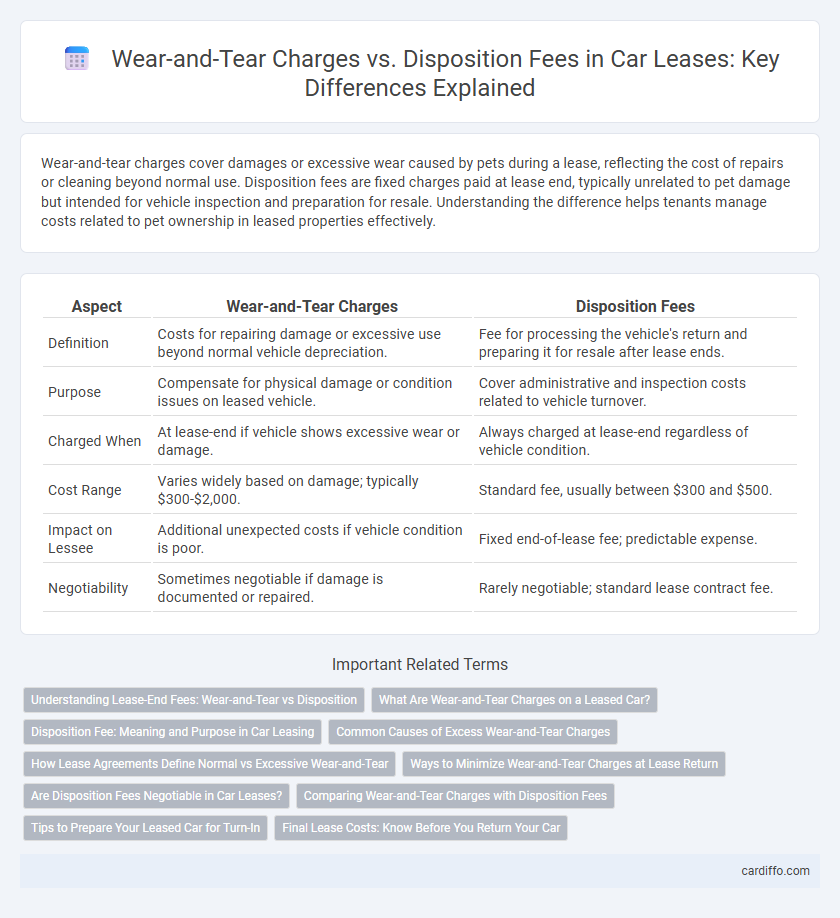Wear-and-tear charges cover damages or excessive wear caused by pets during a lease, reflecting the cost of repairs or cleaning beyond normal use. Disposition fees are fixed charges paid at lease end, typically unrelated to pet damage but intended for vehicle inspection and preparation for resale. Understanding the difference helps tenants manage costs related to pet ownership in leased properties effectively.
Table of Comparison
| Aspect | Wear-and-Tear Charges | Disposition Fees |
|---|---|---|
| Definition | Costs for repairing damage or excessive use beyond normal vehicle depreciation. | Fee for processing the vehicle's return and preparing it for resale after lease ends. |
| Purpose | Compensate for physical damage or condition issues on leased vehicle. | Cover administrative and inspection costs related to vehicle turnover. |
| Charged When | At lease-end if vehicle shows excessive wear or damage. | Always charged at lease-end regardless of vehicle condition. |
| Cost Range | Varies widely based on damage; typically $300-$2,000. | Standard fee, usually between $300 and $500. |
| Impact on Lessee | Additional unexpected costs if vehicle condition is poor. | Fixed end-of-lease fee; predictable expense. |
| Negotiability | Sometimes negotiable if damage is documented or repaired. | Rarely negotiable; standard lease contract fee. |
Understanding Lease-End Fees: Wear-and-Tear vs Disposition
Wear-and-tear charges refer to costs for repairing excessive damage or deterioration on a leased vehicle beyond normal use, such as deep scratches or broken parts. Disposition fees are flat charges imposed by lessors to cover the cost of preparing the vehicle for resale after lease return, regardless of the vehicle's condition. Understanding these lease-end fees helps lessees plan for potential expenses and avoid surprises when returning their leased cars.
What Are Wear-and-Tear Charges on a Leased Car?
Wear-and-tear charges on a leased car refer to fees assessed for damages or excessive deterioration beyond normal usage during the lease term. These charges cover repairs for issues like dents, scratches, tire wear, and interior stains that exceed lease agreement standards. Lease agreements typically define acceptable wear, and exceeding these limits results in additional costs at lease-end.
Disposition Fee: Meaning and Purpose in Car Leasing
The disposition fee in car leasing is a predetermined charge applied when the lessee returns the vehicle at the end of the lease term without purchasing it. This fee covers the lessor's costs of preparing and reselling the vehicle, including inspection, refurbishment, and marketing expenses. Unlike wear-and-tear charges, which address physical damage or excessive use, the disposition fee is a fixed cost intended to streamline lease-end processes and offset vehicle resale efforts.
Common Causes of Excess Wear-and-Tear Charges
Excess wear-and-tear charges on a lease often result from visible damages such as deep scratches, dents, and upholstery stains that go beyond normal use. Failure to address tire wear, cracked windshields, or broken lights may also lead to additional fees at lease-end. Understanding common causes like these helps lessees minimize unexpected costs and maintain vehicle condition within acceptable limits.
How Lease Agreements Define Normal vs Excessive Wear-and-Tear
Lease agreements clearly define normal wear-and-tear as minor scratches, slight tire wear, or small interior scuffs that occur with everyday use. Excessive wear-and-tear includes significant dents, deep scratches, upholstery tears, or mechanical damage beyond expected use. These definitions determine whether charges apply at lease-end, with wear-and-tear charges addressing repairs and disposition fees covering administrative costs of vehicle return.
Ways to Minimize Wear-and-Tear Charges at Lease Return
To minimize wear-and-tear charges at lease return, regularly maintain the vehicle by addressing minor dents, scratches, and tire wear before the lease ends. Using protective seat covers and floor mats can prevent interior damage, while professional detailing can restore cleanliness and reduce the appearance of wear. Documenting the vehicle's condition with photos at lease inception and prior to return helps dispute unfair charges effectively.
Are Disposition Fees Negotiable in Car Leases?
Disposition fees in car leases are often standard charges intended to cover the costs of preparing a vehicle for resale, and while they are disclosed upfront in the lease agreement, they can sometimes be negotiable depending on the dealer or leasing company's policies. Unlike wear-and-tear charges, which typically address damage or excessive use beyond normal limits, disposition fees are fixed and may be waived or reduced through negotiation at lease inception or lease-end, especially with strong credit or loyalty incentives. Understanding the lease terms and proactively discussing disposition fee flexibility can lead to potential savings and a more tailored lease agreement.
Comparing Wear-and-Tear Charges with Disposition Fees
Wear-and-tear charges are fees imposed on leaseholders for excess vehicle damage beyond normal use, reflecting maintenance costs due to dents, scratches, or mechanical issues. Disposition fees, by contrast, cover the leasing company's expenses for cleaning, inspecting, and preparing the vehicle for resale at lease end. Understanding the distinction between wear-and-tear charges and disposition fees helps lessees anticipate potential end-of-lease expenses and negotiate more effectively.
Tips to Prepare Your Leased Car for Turn-In
To avoid unexpected costs at lease end, thoroughly inspect your leased car for wear-and-tear damages such as scratches, dents, and worn tires that exceed normal usage limits. Schedule necessary repairs before the turn-in date to minimize wear-and-tear charges, which are typically based on the condition of the vehicle compared to what's considered normal depreciation. Understanding that disposition fees are fixed charges for ending the lease helps you budget accordingly, while proactive maintenance and cleaning can reduce additional charges and streamline the return process.
Final Lease Costs: Know Before You Return Your Car
Wear-and-tear charges cover physical damage to the vehicle beyond normal usage, such as dents, scratches, or tire wear, impacting the final lease costs when returning a leased car. Disposition fees are flat amounts charged by the leasing company to cover the cost of cleaning and selling the vehicle after lease termination, separate from any damage fees. Understanding these costs upfront helps lessees avoid unexpected charges and efficiently manage their lease-end expenses.
Wear-and-Tear Charges vs Disposition Fees Infographic

 cardiffo.com
cardiffo.com